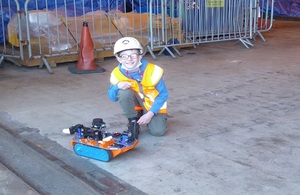More than 500,000 families used Tax-Free Childcare in the last year
New Tax-Free Childcare statistics from HM Revenue and Customs (HMRC) have revealed that 512,415 families received up to £2,000 towards the cost of their childcare during the 2021 to 2022 tax year, up from 374,135 in the previous year.
Tax-Free Childcare provides thousands of eligible working families with vital financial support towards the cost of their childcare with the government paying £240 million annually in top-up payments to families using the scheme.
For thousands of families who use Tax-Free Childcare, the money they save each month on their childcare costs is money that goes back into their pockets.
For every £8 paid into a Tax-Free Childcare online account, families will automatically receive an additional £2 in government top-up, and it is available for children aged up to 11, or 17 if the child has a disability.
Families receive up to £500 every 3 months, per child, or £1,000 if their child is disabled, helping towards the cost of before and after-school clubs, childminders and nurseries, holiday clubs and other approved childcare schemes.
But hundreds of thousands of families could be missing out, with recent research published by HMRC estimating that about 1.3 million families could be eligible for this government support.
Myrtle Lloyd, HMRC’s Director General for Customer Services, said:
Tax-Free Childcare can make a big difference to families, helping with the bills for things like nurseries, childminders and after school clubs. It’s easy to register – search ‘Tax-Free Childcare’ on GOV.UK.
Helen Whately, HM Treasury’s Exchequer Secretary to the Treasury, said:
It’s fantastic that more parents are taking up Tax-Free Childcare. This support provides a helping hand with childcare costs for working families.
With over one million families eligible, I want to encourage parents to take advantage of Tax-Free Childcare and keep the extra pounds in their pocket.
The latest monthly comparisons also show that a record number of families were using their Tax-Free Childcare account in March 2022 – 384,280 families compared to 282,230 in March 2021 – an increase of 102,050 families.
The scheme offers a 20% government funded top-up on money deposited into Tax-Free Childcare accounts, which can be used to pay their childcare provider. Accounts can be opened at any time of the year and can be used straight away, and money can be deposited at any time and used when needed.
For example, if parents and carers have school-aged children and use holiday clubs during school holidays, they could deposit money into their accounts throughout the year. This means they could spread the cost of childcare while also benefitting from the 20% government top-up. Any unused money that is deposited can be simply withdrawn at any time.
Tax-Free Childcare is also available for pre-school aged children attending nurseries, childminders, or other childcare providers. Families with younger children will often have higher childcare costs than families with older children, so the tax-free savings can really make a difference.
Childcare providers can also sign up for a childcare provider account via GOV.UK to receive payments from parents and carers via the scheme.
For more information about Tax-Free Childcare.
For more information about government childcare offers.
Parents and carers could be eligible for Tax-Free Childcare if they:
- have a child or children aged up to 11. They stop being eligible on 1 September after their 11th birthday. If their child has a disability, they may get up to £4,000 a year until they are 17
- earn, or expect to earn, at least the National Minimum Wage or Living Wage for 16 hours a week, on average
- each earn under £100,000 per annum
- do not receive tax credits, Universal Credit or childcare vouchers
Latest Tax-Free Childcare statistics were released on 25 May 2022. Data is available up to March 2022 and also gives regional breakdown figures.
HMRC has produced a refreshed Tax-Free Childcare guide for parents, which explains the reasons and benefits for signing up to the scheme.
Each eligible child requires their own Tax-Free Childcare account. If families have more than one eligible child, they will need to register an account for each child. The 20% government top-up is then applied to deposits made for each child, not household.
Account holders must confirm their details are up to date every 3 months to continue receiving the government top-up.
